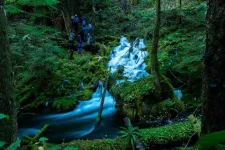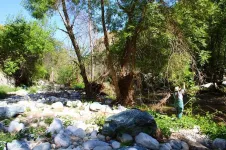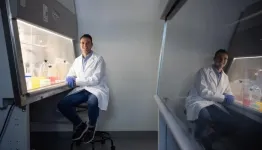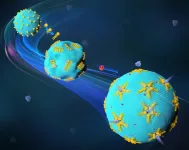(Press-News.org) THIS PUBLICATION IS EMBARGOED UNTIL 3 PM EASTERN TIME ON JANUARY 13, 2025.
Oregon’s Cascade Range mountains might not hold gold, but they store another precious resource in abundance: water.
Scientists from the University of Oregon and their partners have mapped the amount of water stored beneath volcanic rocks at the crest of the central Oregon Cascades and found an aquifer many times larger than previously estimated — at least 81 cubic kilometers.
That’s almost three times the maximum capacity of Lake Mead, the currently overdrawn reservoir along the Colorado River that supplies water to California, Arizona and Nevada, and greater than half the volume of Lake Tahoe.
The finding has implications for the way scientists and policymakers think about water in the region — an increasingly urgent issue across the Western United States as climate change reduces snowpack, intensifies drought and strains limited resources.
It also shapes our understanding of volcanic hazards in the area. Magma interacting with lots of water often leads to explosive eruptions that blast ash and gas into the air, rather than eruptions with slower-moving lava flows.
“It is a continental-size lake stored in the rocks at the top of the mountains, like a big water tower,” said Leif Karlstrom, a UO earth scientist who led the study alongside collaborators from Oregon State University, Fort Lewis College, Duke University, the University of Wisconsin, the U.S. Forest Service and the U.S. Geological Survey.
“That there are similar large volcanic aquifers north of the Columbia Gorge and near Mount Shasta likely make the Cascade Range the largest aquifer of its kind in the world.”
The team reported the findings in a paper published Jan. 13 in the journal Proceedings of the National Academy of Sciences.
Most Oregonians rely on water that originates from the Cascades. For example, the McKenzie River, which supplies most of Eugene’s drinking water, begins high in the mountains at the spring-fed Clear Lake. But the discovery of this underground aquifer’s size was a surprise.
“We initially set out to better understand how the Cascade landscape has evolved over time, and how water moves through it,” said study co-author Gordon Grant, a geologist with the Forest Service. “But in conducting this basic research, we discovered important things that people care about: the incredible volume of water in active storage in the Cascades and also how the movement of water and the hazards posed by volcanoes are linked together.”
The western Cascades are characterized by steep slopes and deep valleys carved out by rivers. The high Cascades, meanwhile, are flatter, dotted with lakes and volcanic topography such as lava flows. The Cascade Range has been built up by volcanic activity over millions of years, making the exposed rocks in the high Cascades much younger than those in the western Cascades.
As a result, the transition zone between the western Cascades and the high Cascades around Santiam Pass is a natural laboratory for understanding how volcanoes have shaped Oregon’s landscape.
“What motivates our work is that it's not just how these landscapes look different topographically. It's that water moves through them in really different ways,” Karlstrom said.
To better understand the flow of water through different volcanic zones, the team took advantage of projects begun in the 1980s and 90s. Past scientists had drilled deep into the ground and measured temperatures at different depths as part of the search for geothermal energy resources associated with the many hot springs that pepper the Cascades landscape.
Normally, rocks get hotter as you go deeper into the earth. But water percolating downward disrupts the temperature gradient, making rocks a kilometer deep the same temperature as rocks at the surface.
By analyzing where the temperature starts to pick up again in these deep drill holes, Karlstrom and his colleagues could infer how deeply groundwater was infiltrating through cracks in the volcanic rocks. That allowed them to map the volume of the aquifer.
Previous estimates of water availability in the Cascades took the springs at face value, measuring river and stream discharge. Instead, Karlstrom and his colleagues went deeper — literally. But since those holes weren’t originally drilled with the intent of mapping groundwater, they don’t cover every area where one might like to collect such data. So the new estimate of the size of the aquifer is a lower bound, and the actual volume might be even bigger still.
While it’s encouraging news that the aquifer is so much larger than previously believed, Karlstrom cautions that it’s still a limited resource that must be carefully stewarded and needs further study.
“It is a big, active groundwater reservoir up there right now, but its longevity and resilience to change is set by the availability of recharging waters,” he said.
The aquifer is largely replenished by snow, and snowpack in the high Cascades is expected to rapidly decrease in the coming decades. More precipitation is expected to fall as rain, which may impact the amount of recharge feeding the high Cascade aquifer. And while it’s likely resilient to small year-to-year fluctuations, many years in a row of low rainfall or no snowpack would probably be a different story.
“This region has been handed a geological gift, but we really are only beginning to understand it,” Grant said. “If we don’t have any snow, or if we have a run of bad winters where we don’t get any rain, what’s that going to mean? Those are the key questions we’re now having to focus on.”
—By Laurel Hamers, University Communications
This research was supported by the National Science Foundation and the U.S. Forest Service.
END
Atop the Oregon Cascades, UO team finds a huge buried aquifer
2025-01-13
ELSE PRESS RELEASES FROM THIS DATE:
Bay Area community leader champions CPR education and heart health on national platform
2025-01-13
DALLAS, Jan. 13, 2025 — Corey Bentley, an American Heart Association local volunteer and marketing professional in the San Francisco Bay Area, is the Association’s 2024 National Leaders of Impact™ Winner. In the fall of 2024, more than 300 local leaders in 60 communities volunteered to improve heart health while raising funds to fuel the lifesaving mission of the Association, through its nationwide Leaders of Impact campaign. The head-to-head competition doesn’t just focus on raising critical funds. It also supports access to equitable health in local communities given that health inequities related to uncontrolled high blood pressure rates, tobacco ...
Aston University and Birmingham Children’s Hospital study shows diagnosis and treatment of preschool wheeze needs improvement
2025-01-13
Preschool wheeze is a common condition in children under six, affecting 30-40% of children
Aston University’s Dr Gemma Heath led a study into parents’ experiences of managing preschool wheeze, including confusion and psychological distress
They identified problems with inconsistent terminology and uncertainty around diagnosis and say a unified approach is needed.
A study led by Aston University’s Dr Gemma Heath and Dr Prasad Nagakumar from Birmingham Children’s Hospital, has shown that treatment and diagnosis for preschool wheeze needs more effective ...
Manure management in China cuts river antibiotic pollution but raises groundwater contamination risks
2025-01-13
A recent study published in Environmental Science and Ecotechnology reveals significant changes in antibiotic pollution patterns in China’s water systems over the past decade, driven by evolving manure management practices. Conducted by researchers from China Agricultural University and Wageningen University, the study developed the MARINA-Antibiotics (China-1.0) model to track antibiotic flows from livestock manure into rivers and groundwater across 395 sub-basins between 2010 and 2020.
The study found a 59% decrease in antibiotic pollution in rivers, primarily due to improved manure recycling and reduced direct manure discharge into waterways. However, ...
New book provides big recommendations from the Advancing the Science of Cancer in Latinos Conference
2025-01-13
SAN ANTONIO, Jan. 13, 2025 – With cancer still rising in the U.S. Latino population, leaders at The University of Texas Health Science Center at San Antonio (UT Health San Antonio) and national cancer experts have published an online book with innovative recommendations to reduce Latino cancer.
The book, “Advancing the Science of Cancer in Latinos: 2024 Conference Proceedings,” highlights results of the same-named conference that brought 300 researchers, advocates and survivors to San Antonio in February 2024.
A follow-up conference is planned for Feb. 18-20, 2026, in San Antonio.
Included ...
Ash tree variability may offer restoration path post-beetle decimation
2025-01-13
UNIVERSITY PARK, Pa. — The invasive emerald ash borer, according to the U.S. Department of Agriculture, was first found in the United States in southeast Michigan in 2002. In the decades since, the wood-boring beetle has spread east and west across the U.S. and Canada, killing tens of millions of ash trees, causing one of the costliest forest insect invasions to date. More than 90% of all ash infested by the insect native to Asia eventually die, threatening to make the tree species functionally extinct in North America. In response, researchers at Penn State are working with the U.S. Forest Service and other partners to identify and develop ...
Integrating CRISPR and biomaterials engineering: Paving the way for safer gene therapies
2025-01-13
CRISPR is a powerful gene-editing tool that holds enormous potential for treating genetic diseases by allowing scientists to cut, replace, or delete mutations in DNA. It can also modify gene expression, temporarily amplifying or diminishing its effects.
Yet, despite its promise, applying CRISPR (which is a reagent, or a substance that facilitates a reaction) in patients presents significant challenges.
“CRISPR is difficult to control when you want to do gene editing in vivo, or directly in the patient,” says Tomas Gonzalez-Fernandez, an assistant professor of bioengineering in Lehigh University’s P.C. Rossin College of Engineering ...
New tool for synthetic biology
2025-01-13
Scientists at the University of Stuttgart have succeeded in controlling the structure and function of biological membranes with the help of "DNA origami". The system they developed may facilitate the transportation of large therapeutic loads into cells. This opens up a new way for the targeted administration of medication and other therapeutic interventions. Thus, a very valuable instrument can be added to the toolbox of synthetic biology. Prof. Laura Na Liu and her team published their findings in the journal Nature Materials (DOI: 10.1038/s41563-024-02075-9).
The ...
Yu & Martin adapting mixed reality training programs to real-world scenes to enhance human-AI teaming in emergency responses
2025-01-13
Lap Fai (Craig) Yu, Associate Professor, Computer Science, College of Engineering and Computing, and Joel Martin, Associate Professor, Kinesiology, College of Education and Human Development, received funding for the project: “EAGER: TaskDCL: Adapting Mixed Reality Training Programs to Real-World Scenes to enhance Human-AI Teaming in Emergency Responses.”
This EArly-concept Grant for Exploratory Research (EAGER) project funds research that intends to speed up the development of mixed reality and artificial intelligence (AI) technologies to help ...
ExxonMobil donates $10 million to fund MD Anderson-led Be Well™ Beaumont initiative
2025-01-13
HOUSTON and BEAUMONT, TEXAS ― In an effort to improve public health and reduce cancer risk in East Texas, leaders in Beaumont are working with The University of Texas MD Anderson Cancer Center to launch Be Well™ Beaumont through a newly announced $10 million gift from ExxonMobil. Community members, collaborators and representatives from MD Anderson kicked off the 10-year initiative today in Beaumont.
Be Well Beaumont aims to promote wellness and to lower cancer risk among community members by providing them with cancer prevention education and tools. ...
Long reads successfully used to find genetic causes of rare diseases
2025-01-13
The cause of rare diseases is increasingly being detected through genome sequencing, which involves reading the entire human DNA by first breaking it into small pieces—short reads. Christian Gilissen, Lisenka Vissers, and colleagues found that a new technique using long reads is even more effective at detecting complex causes. They report that eighty to ninety percent of cases were detectable, as stated in the American Journal of Human Genetics.
Rare diseases are typically due to genetic causes. These causes are more and ...




